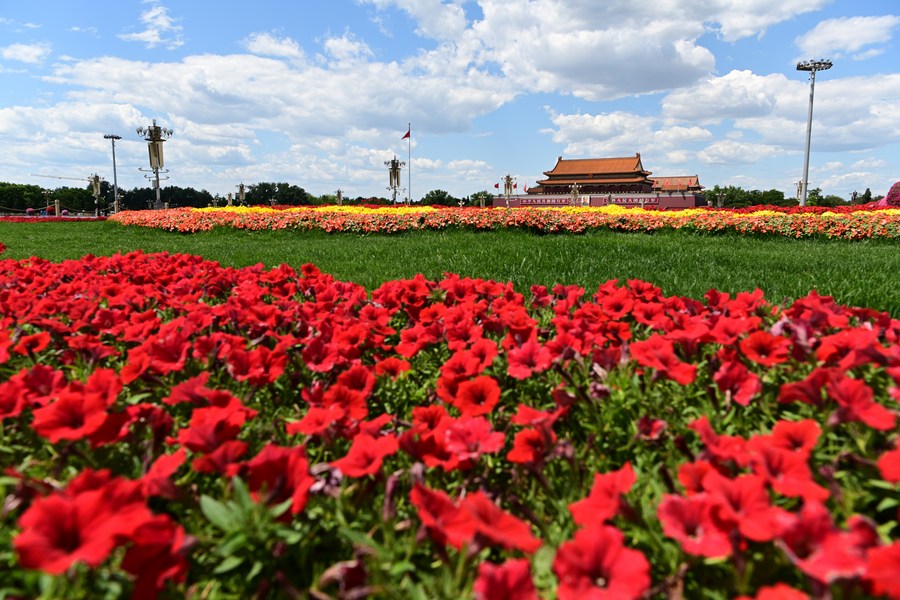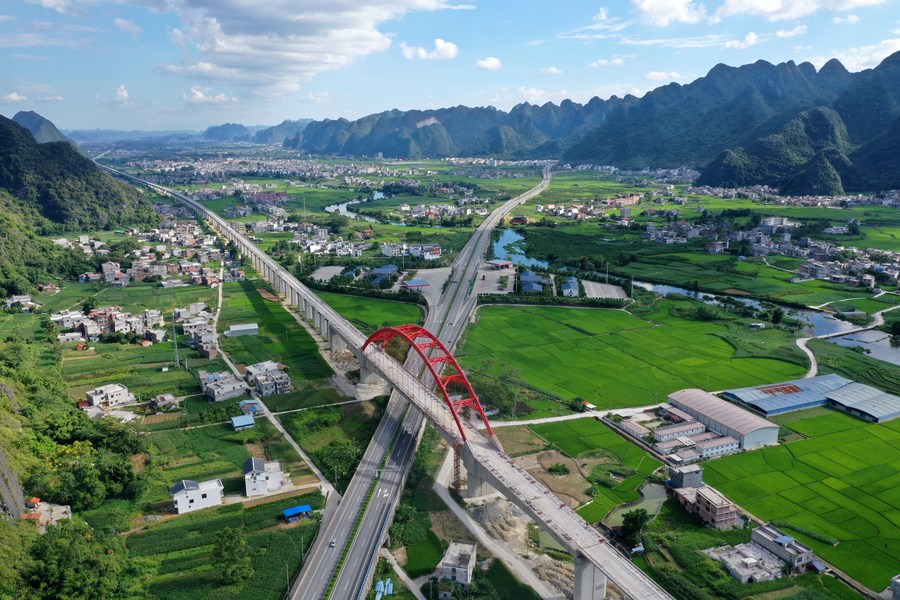Chinese path to modernization: Characteristics and global significance
The formation and extension of the uniquely Chinese path to modernization show the vitality and advantages of socialism with Chinese characteristics, demonstrating that modernization need not mean “Westernization,” which is of great significance to both China and the wider world.

Photo taken on May 27, 2020 shows a view of the Tian'anmen Square in Beijing, capital of China. (Xinhua/Liu Jinhai)
The Communist Party of China (CPC) has led the people in pioneering a uniquely Chinese path to modernization, creating a new model for human advancement, and expanding the channels for developing countries to achieve modernization, as pointed out in the Resolution on the Major Achievements and Historical Experience of the Party over the Past Century.
“This has offered a new option for countries and nations who want to accelerate development while preserving their independence,” said the resolution as adopted at the sixth plenary session of the 19th CPC Central Committee.
The uniquely Chinese path to modernization, a great innovation in human history, has resolved many problems as regards human development. The formation and extension of the uniquely Chinese path to modernization show the vitality and advantages of socialism with Chinese characteristics, demonstrating that modernization need not mean “Westernization,” and are of great significance to both China and the wider world.
Since the 18th CPC National Congress, under the sound guidance of Xi Jinping Thought on Socialism with Chinese Characteristics for a New Era, the CPC has united and led the Chinese people in pressing ahead with the country’s Chinese-style modernization to make new contributions to humanity’s search for alternative ways to successfully modernize.
A thorough understanding of the characteristics and global significance of Chinese-style modernization is essential for thoroughly studying and implementing CPC Central Committee General Secretary Xi Jinping’s major expositions on Chinese-style modernization.
Characteristics of the uniquely Chinese path to modernization
The main characteristics of the uniquely Chinese path to modernization during its formation process include the following three aspects.
Upholding the leadership of the CPC. An examination of the history of the economy and economic thought shows that for late-developing countries, an active and strong ruling party is the key to realizing rapid economic development. This is also the key to the formation and extension of the uniquely Chinese path to modernization. During the modernization process of a late-developing country, the ruling party plays a significant role in leading the people to lay foundations and create conditions that are not otherwise available but necessary for the country’s rapid economic development, including infrastructure, legal systems, industrial policies, education and training.
China’s internal and external constraints have always undergone dynamic changes during the process of pursuing socialist modernization. Facing complex and changing external and internal environments, China has, under the strong leadership of the CPC, realized “two miracles” – rapid economic development and long-term social stability – having done so by scientifically formulating and improving short-and medium-term modernization goals, adhering to the long-term goal of building a modern socialist country, as well as fully tapping potential and seizing opportunities.
During this process, the CPC has fully demonstrated its foresight and strong political leadership, as well as its strength in thought guidance, mass organization and social mobilization. The Party has also lived up to its original aspiration and founding mission to seek happiness for the people and rejuvenate the Chinese nation, all while showcasing its distinctive character: that is, to have the courage to carry out self-reform.

Photo taken on Jan. 2, 2021 shows the light show at the Lujiazui area in east China's Shanghai. (Xinhua/Wang Xiang)
From the periods of the new-democratic revolution, socialist revolution and construction, and reform and opening up to a new era of socialism with Chinese characteristics, reflecting on the exploration and practice of China’s modernization reveals that without the CPC, which has upheld lofty ideals and strong beliefs and has always represented the fundamental interests of all Chinese people, China would not have been able to bring together and mobilize the whole society in a complex, difficult and changing environment. Without the CPC, it would be impossible for China to always adhere to the right direction of development. It would be even more impossible for China to deepen its reform and opening up and pioneer a uniquely Chinese path to modernization.
In the world’s history, only the CPC, a Marxist party that is the choice of history and the people, can take realizing, defending, and developing the fundamental interests of the overwhelming majority of the people as its immutable aim. Only under the leadership of the CPC can China insist that development is for the people, reliant on the people, and that its fruits should be shared by the people, and pioneer a uniquely Chinese path to modernization, creating a new form for human advancement.
Therefore, the leadership of the CPC is the defining feature of socialism with Chinese characteristics, the greatest strength of the system of socialism with Chinese characteristics, and the fundamental guarantee for the formation and development of the uniquely Chinese path to modernization.
Staying independent. “We must follow our own path. This is the bedrock that underpins all the theories and practices of our Party. More than that, it is the historical conclusion our Party has drawn from its struggles over the past century,” said General Secretary Xi Jinping while delivering a speech at the ceremony marking the centenary of the CPC. The resolution adopted during the sixth plenary session of the 19th CPC Central Committee summarized 10 items of historical experience for the Party over the past century, including “staying independent.”
Staying independent is a distinctive feature of the CPC in leading the people to explore the uniquely Chinese path to modernization. The history of the world since the Second World War has fully proven that it is not easy for late-developing countries to modernize in an international political and economic system built and dominated by Western developed countries. Some late-developing countries have paid a price in losing their independence to seek dependent development, having ended up falling into various “development traps.”

Aerial photo taken on Aug 31, 2021 shows a high-speed railway under construction and an expressway in Gaoling township of Du'an Yao autonomous county, South China's Guangxi Zhuang autonomous region. (Photo/Xinhua)
The uniquely Chinese path to modernization has come about as a result of the CPC having led the Chinese people to remain committed to independence and working in concert, and is in tune with China’s national conditions and realities. On the uniquely Chinese path to modernization, China completed its process of industrialization, a process that took developed countries several centuries, in the span of mere decades. The Chinese nation has achieved a tremendous transformation from standing up and growing prosperous to becoming strong.
The world is experiencing the combined impacts of major changes and a pandemic unseen in a century. Unilateralism and protectionism are on the rise, and economic globalization is facing headwinds. General Secretary Xi Jinping proposed to accelerate the fostering of a new development paradigm with domestic circulation as the mainstay and domestic and international circulations reinforcing each other, and mentioned that the essence of the new development paradigm is realizing a high level of self-reliance. This elucidates the path that will take China to economic modernization during the new development stage and bears important and far-reaching significance for promoting China’s high-quality economic and social development and global economic prosperity.
Adhering to simultaneous development. Although modernization does not only mean industrialization and economic development, industrialization and economic development are undoubtedly the most important parts of modernization. Experience in the global sphere shows that modernization driven by industrialization is an inevitable path for both developed countries and late-developing countries. From the 156 key projects listed in China’s first Five-Year Plan (1953-1957) to the new type of industrialization since the period of reform and opening up, industrialization has always been the main basis and driving force for China’s modernization.

A duty-free store in Riyue Plaza in Haikou city, capital of south China’s Hainan province, is crowded with customers, Jan. 1, 2022. (People’s Daily Online/Wang Chenglong)
In the new era, General Secretary Xi Jinping proposed that industrialization, informationization, urbanization and agricultural modernization should be promoted simultaneously. This is a major innovation in modernization theory and shows that the Party has a deeper understanding of the laws of modernization and a clearer understanding of the uniquely Chinese path to modernization.
General Secretary Xi Jinping pointed out that China’s modernization is different from that of developed Western countries. The modernization of developed Western countries is like a “series connection” process during which industrialization, urbanization, agricultural modernization, and informatization have taken place in a sequence, having taken over 200 years to reach the current level. Given the fact that China is a latecomer, the country’s modernization process must therefore be a “parallel connection” process, during which industrialization, informationization, urbanization and agricultural modernization are developed simultaneously.
The thought and practice of modernization featuring the “parallel connection” process greatly improved China’s productivity. From 1952 to 2021, China’s GDP jumped from 67.91 billion yuan to more than 110 trillion yuan, while its GDP per capita increased from 119 yuan to over $12,000. Since the reform and opening up, the average annual growth rate of China’s GDP was 9.2 percent during the years between 1978 and 2020. It is undoubtedly a miracle in the world’s modernization history for a poor and backward developing country with a large population to achieve such sustained and stable rapid development in such a short period of time.
The global significance of the uniquely Chinese path to modernization
The formation and extension of the uniquely Chinese path to modernization are of great significance to not only China, but also the world at large.
The Chinese path to modernization broadens the path toward modernization for developing countries. The uniquely Chinese path to modernization abandons the old Western way of modernization, which is capital-centric, polarized, and is characterized by soaring materialism and external expansion and plundering, being an old-fashioned way of modernization. Chinese-style modernization broadens the path toward modernization for developing countries, and provides a Chinese solution in mankind’s search for a better social system.
The uniquely Chinese path to modernization proves that there is no fixed path toward modernization, showing that whichever path best suits the national conditions of an individual country is the best path forward, while “cutting one’s feet to fit the shoes” will lead nowhere.

A farmer works in the field in Changping Village, Moudao Township of Lichuan City, Enshi Tujia and Miao Autonomous Prefecture, central China's Hubei Province, March 28, 2022. (Photo by Wen Lin/Xinhua)
Developing countries should be committed to their own goal of modernization and explore a path toward modernization that suits their own national conditions. The huge gap between the present backwards state of development and a vision for future development should provide a strong motivation and driving force for the acceleration of modernization, but never should be an excuse to stop pursuing an independent and self-reliant path toward modernization.
Developing countries, in an attempt to turn their strong aspiration for modernization into actual results for economic and social development, need a powerful ruling party which always represents the interests of the people. Only under the leadership of such a party can developing countries pool together the consensus of the people, represent the interests of the people, and move steadfastly toward their goal of modernization, while catching up with the developed countries.
China’s path toward modernization answers the major question of how socialist countries can realize modernization. This Chinese-style modernization is a socialist modernization. Socialist countries and capitalist countries have different goals for economic development, and the characteristics and logics of modernization are different, too. In the capitalist world, modernization follows the logic of capital, and to relieve the contradictions of capital accumulation and satisfy the need for capital increment are the most fundamental and crucial factors.
The CPC represents the fundamental interests of the overwhelming majority of the people of China, and the Party must therefore remain committed to a people-centered philosophy of modernization. Chinese-style modernization must focus on the free and all-round development of the people, and serve the well-being of the people. The Chinese-style modernization seeks to involve a massive population base; it seeks to pursue common prosperity for the people; it promotes coordination between material civilization and spiritual civilization; it is a modernization that guarantees the harmonious co-existence between humans and nature; it is a modernization that takes the road of peaceful development.

Volunteers help pick and sell strawberries via livestreaming platform at a planting base in Banjing township, Rugao city, east China’s Jiangsu province, Feb. 24, 2022. (People’s Daily Online/Xu Hui)
To realize socialist production goals, we creatively launched the socialist market economy, which gives play to the decisive role of the market in resource allocation and allows the government to play a better role. It also gives full play to the role of capital in boosting economic development and prevents capital from growing in a disorderly fashion that goes against the objectives of social production. Based on the fact that the major contradiction of Chinese society has changed, and to enhance people’s well-being and to better satisfy people’s ever-growing aspiration for a better life, we are focusing our efforts on promoting common prosperity and solidly pushing for common prosperity. Chinese-style modernization effectively manifests the essential requirements of socialism, and answers the major question of how socialist countries should realize modernization.
China’s path toward modernization pushes for the progress of mankind and economic globalization. China’s successful exploration of its own path toward modernization has enabled the country to achieve the goal of building a moderately prosperous society in all respects while eradicating absolute poverty, creating a miracle that should be remembered in human history.
Looking to the future, China aims to basically achieve socialist modernization by 2035 and build itself into a “great modern socialist country” by the middle of the 21st century, which means that more than one billion people of the world’s total population will embrace modernization. To build a modernized society for more than one billion people is undoubtedly a huge contribution to the progress of mankind.
Chinese-style modernization is an open modernization, as well as one that conforms to the trend of globalization and the progress of human society. As the largest developing country in the world, China has become an important force in making economic globalization more open, inclusive, balanced and beneficial for all.
While developing itself, China has always proactively shouldered its responsibility, having made contributions to global economic stability.

Aerial photo taken on Aug. 19, 2020 shows wind turbines in Jiucaiping scenic spot in southwest China's Guizhou Province. (Xinhua/Liu Xu)
China has been a ballast stone, a stabilizer, and an engine for world economic growth in various situations, be it the 1998 Asian financial crisis, the 2008 global financial crisis, or the sudden outbreak of the novel coronavirus. By putting forward the Global Development Initiative, calling for and promoting the joint construction of the Belt and Road Initiative, and pledging to have CO2 emissions peak before 2030 and achieve carbon neutrality before 2060 and taking ensuing concrete actions, China has acted as a responsible and broad-minded major country that is engaged in building a community with a shared future for mankind.
This is a translation of 中国式现代化道路的特质与世界意义 on page 9 of the People's Daily published on March 25, 2022.
(Huang Qunhui is a researcher at the Institute of Economics, Chinese Academy of Social Sciences. Yang Hutao is a researcher at the Center of Xi Jinping Thought on Socialism with Chinese Characteristics for a New Era, Chinese Academy of Social Sciences.)
Photos
Related Stories
- China's "two sessions" start in crucial year for modernization
- China eyes substantial progress in modernization of military personnel
- China makes significant strides in modernization drive
- China unveils 5-year plan to advance agricultural, rural modernization
- China's modernization drive unleashes opportunities for world
- Experts illustrate China's whole-process democracy in pursuit of modernization
- 70 years on, Tibet embarks on new journey of modernization
- Each country's independent exploration of modernization path worthy of respect: Xi
- CPC celebrates 100 years, continues modernization push
- China's high-speed railway symbolizes rapid modernization, increasing prosperity: CNN
Copyright © 2022 People's Daily Online. All Rights Reserved.










